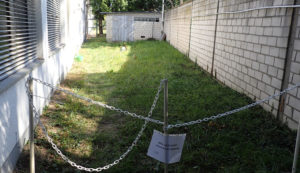Everybody takes environmental concerns serious these times. We all have the feeling that part of our problems is throwing away too many products. It’s no mystery what happens to thrown-away plastics. But what happens to thrown-away wipes? After all, the majority of wipes contain plastics too because single-use wipes often are made from a blend of polyester and viscose fibers.
Interested? Then follow us during the next weeks. We will reveal what really happens to thrown-away, single-use wipes. Our laboratory is roughly at latitude 49° 57′ 57,24” and longitude 8° 40′ 24,96”, a nearly never-trotted lawn at Truetzschler Nonwovens’ Egelsbach site in the mid of Germany.

Plastic waste on a beach

Our laboratory
The set-up
This is our lawn after we set up the experiment. We „threw away“ various nonwoven wipe materials and end products of comparable weights between 45 and 55 grams/square meter. Our samples:
- S01: wet-laid/binder handkerchief from pulp
- S02: 100% wet-laid, unbonded pulp. The only means of bonding are hydrogene bridges.
- S03: wet-laid/spunlaced nonwoven from 60% pulp and 40% lyocell. A dry material without lotion
- S04: wet-laid/spunlaced nonwoven from 60% pulp and 40% lyocell in a water-based lotion
- S05: wet-laid/spunlaced nonwoven from 60% pulp and 40% lyocell in an oil-based lotion
- S06: carded/spunlaced dry wipe from 100% Tencel Skin
- S07: carded/spunlaced dry wipe from 100% bleached cotton
- S08: converted carded/spunlaced wet wipe from 100% cotton
- S09: carded/spunlaced nonwoven from PET and viscose fibers
- S10: carded/spunlaced wet wipe from PET and viscose fibers
We made three identical sample sets:
- The first set was buried in the ground
- We pinned the second set to the lawn so the fabrics lied in the open
- The third set has been exposed to the weather and an occasional shower of rain on a balcony without contact to soil.
What do you think will happen to all of them over time? Stay tuned and read in our next blogpost.










